Introduction
In the 1990s, few characters reached the heights of Sonic the Hedgehog. Shortly after the 1991 launch of the Blue Blur’s debut game on Sega Genesis, his popularity rivaled Nintendo’s behemoth Super Mario franchise. However, much like the roller coasters that inspired Sonic’s original gameplay and level design, the subsequent decades included plenty of highs and lows. Even after a quick jump off the starting line, many feared the series was doomed to fall short of its potential forever.
However, the brand has experienced something of a renaissance in recent years. The Sonic the Hedgehog franchise is perhaps nearly as popular now as when it burst onto the scene just over three decades ago, bolstered by blockbuster movies, beloved comics, and promising streaming shows. Sonic Mania proved a successful retro reinvention, but the core development staff at Sonic Team has yet to deliver the final piece of the puzzle: a mainline game restoring the series’ legacy as one of the premier platformers.
Sega and Sonic Team think they have that final component with Sonic Frontiers. I traveled to Burbank, California, the American headquarters of Sonic Team, to sink hours into the upcoming open-world game to see if it truly is the fresh direction the franchise needs.
A One-Way Track
A One-Way Track
Former director of marketing at Sega of America Al Nilsen will never forget the first time he saw Sonic the Hedgehog in action. Nilsen visited Sega’s research and development team in Tokyo, Japan in the early part of 1990. Months before, Nilsen helped select a rudimentary drawing of a blue hedgehog. It was the new flagship mascot of Sega’s 16-bit era of console gaming, but nobody on the Sega of America side had seen Sonic in motion to that point.
As Nilsen entered the office, he spotted two monitors. On one screen, there was a wireframe environment with something speeding through it. At the same time, the second monitor displayed a beautiful, lush background beyond anything he’d seen in a video game before. He had no idea what it was at first, but it immediately drew him from across the room.
“I got closer, and I was like, ‘Hey! That’s that Sonic guy I saw on a piece of paper way back when,’” Nilsen recalls. “I walked up, and here is Sonic going through the loop-de-loop in Green Hill Zone, but it’s just a wireframe. He was speeding through it, and my jaw just dropped. Then next to it was the background for Green Hill Zone.”
In awe, Nilsen turned to series co-creator Yuji Naka, who he had just met. He asked Naka if it was possible to combine the speed of the wireframe demo with the gorgeous background of the other monitor. When Naka told him it was, Nilsen immediately got on board.
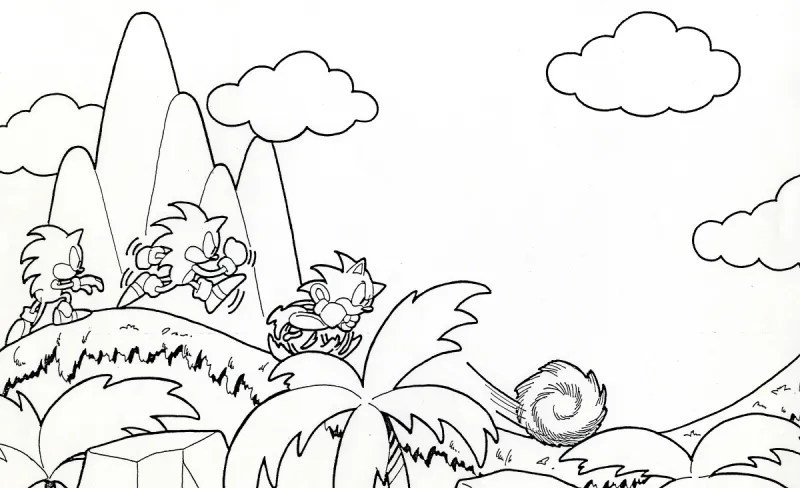
When Nilsen told then-president and CEO of Sega of America Tom Kalinske about the demo, he couldn’t stop singing its praises. “They had never heard me rave about a game so much [as] when I got back, and they just wanted to see it,” says Nilsen. “[That early demo] was what did it for me in terms of going, ‘This is going to be something special for Sega.’ It was amazing.”
“Before Al went to Japan on that trip, we’d only seen drawings,” Kalinske says. “We all knew we needed to have a character for Sega to fight against Nintendo and Mario. All we had were drawings of Sonic, and it was pretty hard to imagine it could be as fast as he turned out to be and as good as he turned out to be.”
Sega knew it had a hit on its hands, but it needed to reveal Sonic at the right time for maximum effect. In 1991, Kalinske and Nilsen began pulling back the curtain. Following an enthusiastic response from players, licensors, and other business partners, Sonic the Hedgehog was well on its way to becoming the next great phenomenon in the video game industry.
But games were just the start. Sonic the Hedgehog became a licensing juggernaut alongside Sega’s critically celebrated games. The United States ran two animated shows simultaneously, while toys, plushies, clothing, and other merchan- dise flooded store shelves. Sega had its hit, but it wasn’t until Sonic the Hedgehog 2 that the Blue Blur truly became a household name.
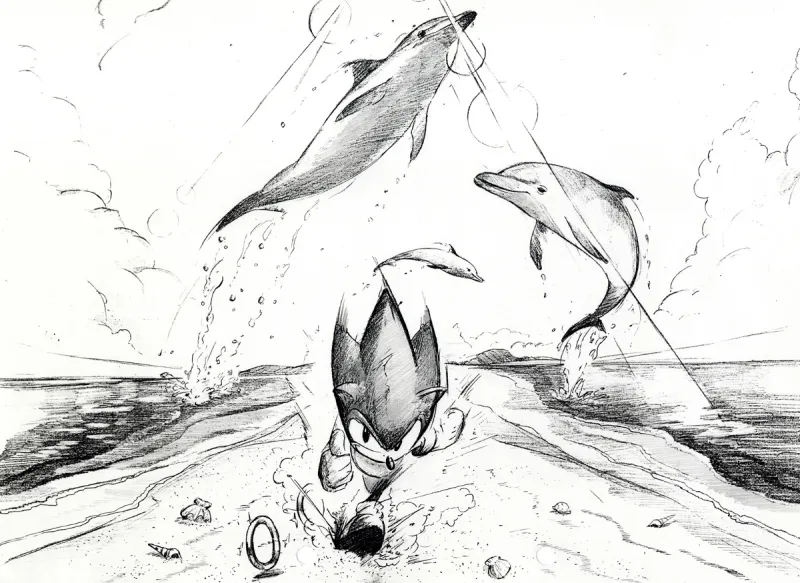
Following an astoundingly successful marketing campaign called “Sonic 2sday” and universal acclaim, Sonic the Hedgehog 2 became the highest-selling game of 1992, outpacing other classics like Street Fighter II and The Legend of Zelda: A Link to the Past. Sonic 2 set the franchise’s ceiling higher than its predecessor. And in the near-term, at least, the series delivered on that potential, with Sonic CD, Sonic the Hedgehog 3, and Sonic & Knuckles all launching to critical and popular praise.
But despite Sonic’s success in the early ’90s, the franchise – and Sega as a whole – experienced a bumpy road in subsequent years. The Saturn, Sega’s attempt at competing with the Nintendo 64, fell short. And the Dreamcast, despite a strong lineup of games (including the beloved Sonic Adventure titles), failed to sell comparably to Sony’s PlayStation 2. Following the discontinuation of Dreamcast, Sega exited the hardware business for good, and Sonic became third-party software appearing on PlayStation, Xbox, and Nintendo platforms.
While Sonic Team creative officer Takashi Iizuka told me he was excited to develop for additional platforms and reach new audiences, the mid-to-late 2000s and early 2010s proved challenging for Sonic. While some games resonated with fans, the series became notorious for promising beyond its capabilities. Fans coined the term “The Sonic Cycle” to describe how they are continually let down by the final product after promising early marketing.
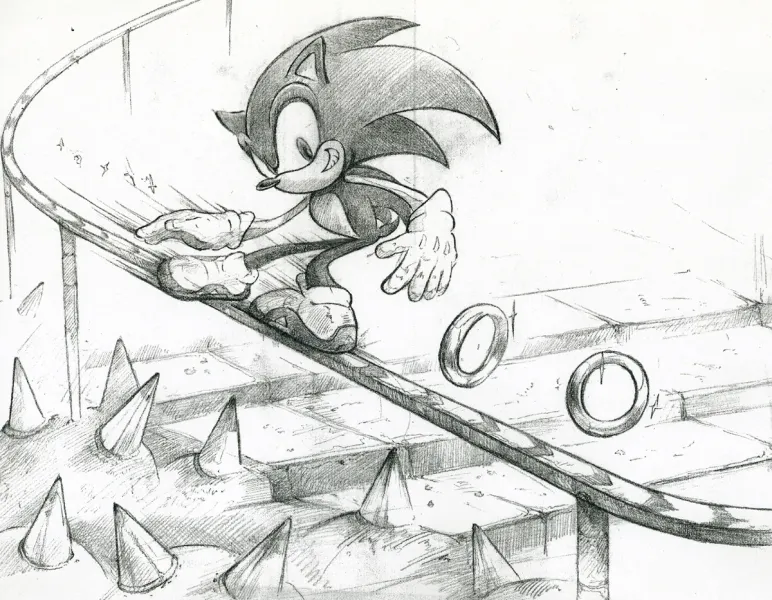
While some small successes popped up during this era – Unleashed, Colors, and Generations being the most noteworthy examples – fans lamented the end of Sonic’s relevance among the platforming elite, and many succumbed to the notion that the hedgehog’s best days were behind him. However, Sega was less willing to accept that idea.
Live And Learn
Live and Learn
In 2015, Sega tried doing something about its track record. According to chief brand & business officer Ivo Gerscovich, who joined the company in 2015, the brand just couldn’t continue down the path it was going from the ’00s, particularly with the games in the Nintendo-exclusive Sonic Boom spin-off franchise. “The quality wasn’t where we wanted or needed [it] to be,” Gerscovich says. “We were also exclusive to one platform, and our audience potentially was a lot wider than that.”
Another tension point for Sonic Team was that many members worked in different locations across the globe. Iizuka, who’s headed up many Sonic Team projects over the last couple of decades, lived in Japan while much of the team was in California. The company restructured its Sonic pillar, moving much of its crew to its current headquarters in Burbank to ease the communication process. But the team knew it needed to address its unhealthy relationship with deadlines and launching games before they were ready.
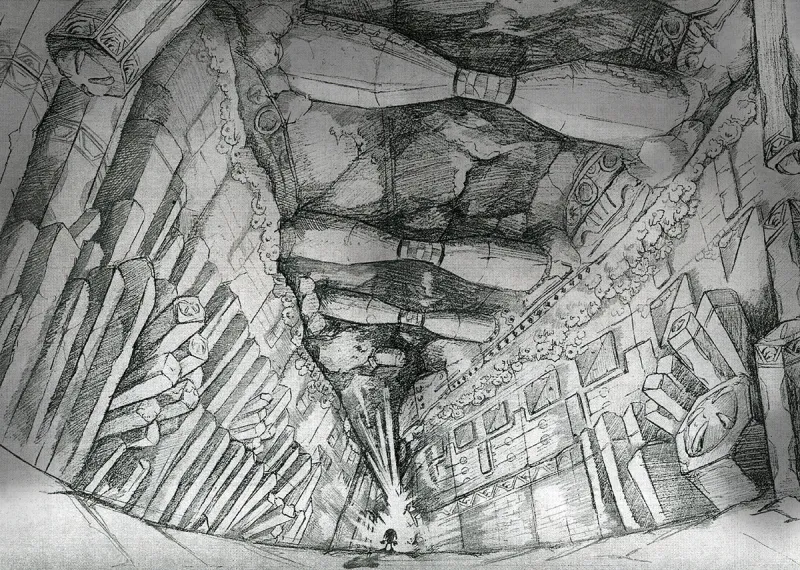
“Any time a game gets the time it deserves, it’s a really good thing,” Gerscovich says. “That being said, there’s always a lot of research and things that go on behind the scenes. There’s gameplay testing, and there’s focus groups, and there’s obviously a very experienced production team. All of those things get factored into decisions, but definitely, Sega has moved towards a quality focus in the last years. You’ve heard that from the chairman [and CEO] Haruki Satomi and myself and many others. We’re all doing everything possible to deliver the best experiences for fans across all platforms.”
The first Sonic game Sega released after the shift was Sonic Boom: Fire & Ice for 3DS, which received a full-year delay to create a better game. Sega rarely used this approach in the prior decade, most notably with the infamous Sonic the Hedgehog (2006), which nearly skipped the entire QA process to meet a deadline. Fire & Ice didn’t turn the world upside-down when it was launched in 2016, but it did show improvements over the other two Sonic Boom titles. However, despite the noticeably better product and the popular Sonic Boom cartoon producing new episodes for another year, Fire & Ice was the final Sonic Boom game released as the brand refocused on its core fan base.
“We had an anniversary about a year later, so we were looking for something fun to really bring back the core fans; a lot of the core fans, I think, felt alienated by Sonic Boom and those video games, and so we wanted to pivot and bring the core fans back knowing they were our bread and butter,” Gerscovich says.
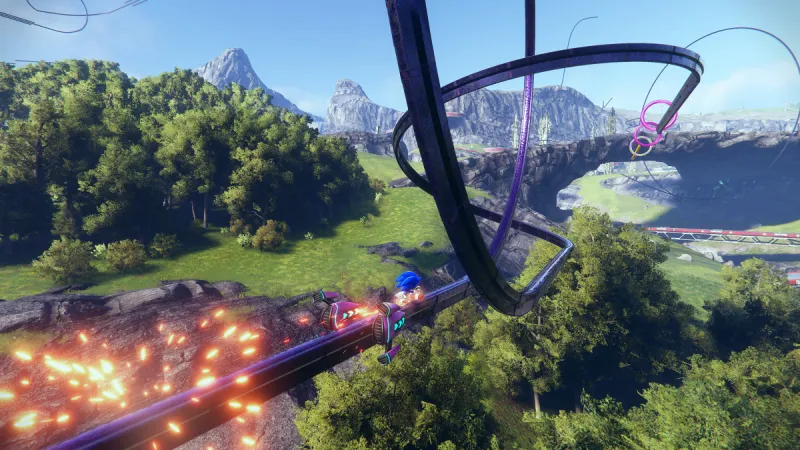
In 2017, Sega released two Sonic games. The first was Sonic Mania, a loving homage to the Genesis days, created by a team of independent developers led by Christian Whitehead. “We started talking with Christian, and I’ll never forget, there was a meeting with Iizuka-san, and Christian flew in from Australia,” Gerscovich recalls. “The team was pitching the idea, and they were going back and forth, and Iizuka-san was a little bit silent. And he stepped out for a few minutes, and then he came back, and he said, ‘Why don’t we do this?’ and he basically had the idea of combining all these different games and calling it ‘Mania.’ And everyone’s jaw dropped in that moment, and we realized that we had something potentially magical.”
Sonic Mania received universal acclaim as one of the best Sonic games ever created. “When we started seeing the early builds of the game, you could already sense that there was something very special,” Gerscovich says. “It’s one of the defining moments, and the team takes a lot of pride because that immediately brought the core back, and it brought a lot of new fans.”
Unfortunately, the second Sonic game of 2017 wasn’t so well-received. Sonic Forces offered players the ability to create their character in a darker storyline involving Eggman defeating Sonic, and an underground resistance fighting back. The tale included several fan-favorite adversaries from the past, but the end of the story fell flat for fans, and many criticized the 2D gameplay, 3D level design, and short story runtime.
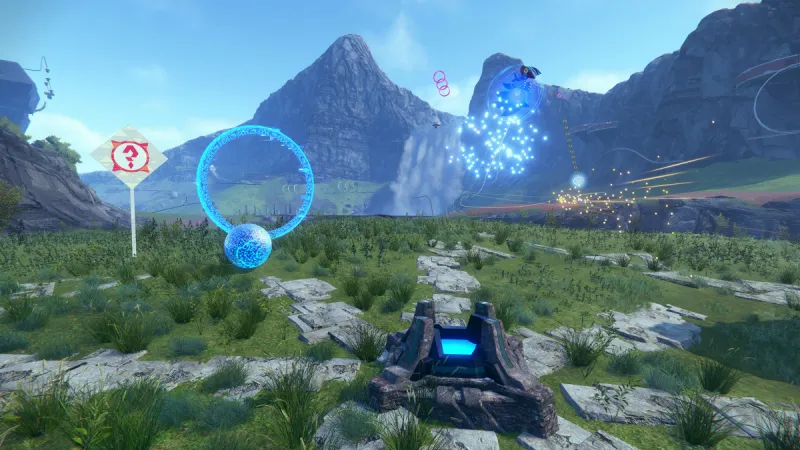
Eggman is featured in several story sequences, but how he fits into the broader narrative remains to be seen
Sonic Forces didn’t give Sega and its flagship franchise the boost it was hoping for. However, thanks to a burgeoning multimedia scene that includes a new comic run at IDW Publishing, a live-action film franchise at Paramount, and an animated streaming series at Netflix, the past few years have been good for the hedgehog.
And now, with the benefit of seven years of course correction and lessons learned from trying to right the ship, Sega believes it is ready to capitalize on the increased brand awareness and deliver better-quality experiences. The open-world Sonic Frontiers is ambitious, engaging, and exciting, but fans have learned to distrust the hype machine thanks to the Sonic Cycle. However, after spending hours with Sonic Team’s latest project, it’s clear this is Sega’s best shot at delivering the game fans have wanted and deserved for the last two decades.
Escape From The City
Escape from the City
True to the hedgehog’s love of speed, Sonic Frontiers wastes little time setting the table for the adventure to come. In the first of two cutscenes, Dr. Eggman arrives on an isolated island and approaches a mysterious artifact. He places a device on the artifact and begins uploading his A.I. “The ancient secrets will be mine!” he excitedly exclaims. However, the island already has its own A.I. (or something like it). A voice from the artifact activates its protection protocol, absorbing Eggman into the object.
The scene cuts away from the mustachioed villain’s apparent defeat, and I see a familiar sight: the Tornado biplane approaching the island. The scene immediately recalls the introduction to Sonic the Hedgehog 3, but with a few clear distinctions. First, Amy Rose is along for the ride, joining Sonic and Tails on this endeavor. Additionally, they aren’t approaching Angel Island, but rather Starfall Islands. And finally, Sonic isn’t going to jump off and turn into Super Sonic; in fact, he doesn’t have any of the seven Chaos Emeralds. Instead, that’s precisely what brings the trio to these islands: They’re tracking those mystical gems.
The skies are clear and smooth as Sonic, Tails, and Amy approach, but the peace doesn’t last long. Tails loses control of the plane, and they fly into a wormhole. When Sonic awakens, he recognizes his surroundings, but something is slightly off. The area where he landed is reminiscent of one of his most familiar locales: Green Hill Zone. Sonic Frontiers has been shown to be open world, but this first sequence is entirely linear.
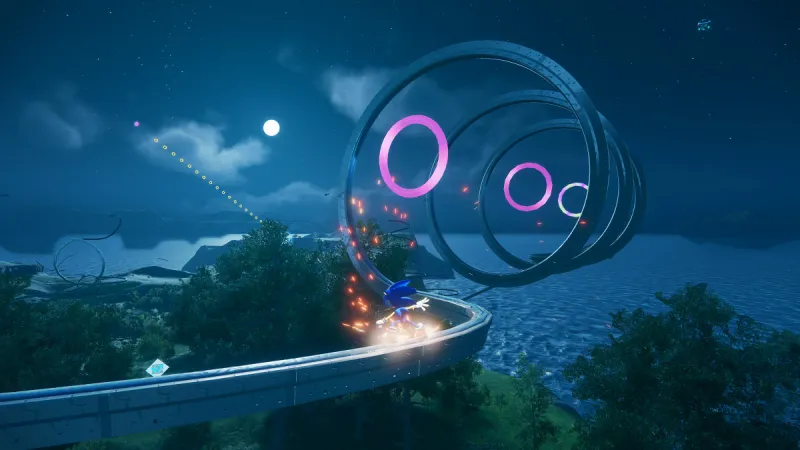
Despite the big change to Sonic Team’s “open-zone” format, Sonic Frontier’s world still features many of the same stage elements players expect from a Sonic game
Though I’m confused at first, I use the stage to get a feel for how Sonic controls in Frontiers. Running through Green Hill, blasting through iconic Badniks like Motobugs who roam the fields, feels as good as ever. Sonic is smooth and fast but not unwieldy. His jumping is precise, aided as always by his useful homing attack, but without feeling like it slows down his momentum. It turns out this excursion to Green Hill Zone is not only a quick detour but also a tutorial. I finish this linear stage in less than a minute and feel good about how the hedgehog controls in linear sequences, but the true test will be in how he adapts to the open world.
After a results screen that shows how I did in stage 1-1, Sonic awakens alone and disoriented. A disembodied voice calls out to the bewildered Sonic. After reacting to Sonic doing “the impossible,” escaping from what it calls “Cyber Space,” it delivers clear, concise instructions: Find the Chaos Emeralds and destroy the Titans. Since Sonic was already trying to track down his favorite gems, he figures this is as good of guidance as any. “Some direction is better than none,” he says with a shrug, and he speeds off into Kronos Island.
His World
His World
After that quick detour through Cyber Space, Frontiers drops me into Kronos Island’s open world (or, as Sonic Team calls it, “open zone”). The tight controls I experienced in the tutorial feel even better now that I can freely explore.
“With previous 3D Sonic games, it was difficult to give the players freedom,” Iizuka says. “That’s because you need a path to provide a high-speed experience, and you could only play on that path. The open-zone concept gets rid of that path and provides an action experience with freedom.”
After getting the hang of the camera controls and Sonic’s open-zone movement, I stumble upon an obelisk-style shrine. These pillars serve as portals to the more traditional Cyber Space stages, like the Green Hill one I played for my tutorial. I decide to keep exploring Kronos Island instead.
Coming into my hands-on time, I worried about how Sonic would control in the open zone. I imagined scenarios where the hedgehog would be too slippery, too fast, or flat-out too imprecise to truly take advantage of the game’s exploration elements. After all, one of the biggest appeals to the open world in games like The Legend of Zelda: Breath of the Wild is how rewarding methodical exploration and investigation proves. Zipping through the open area of the island again feels speedy but controlled.
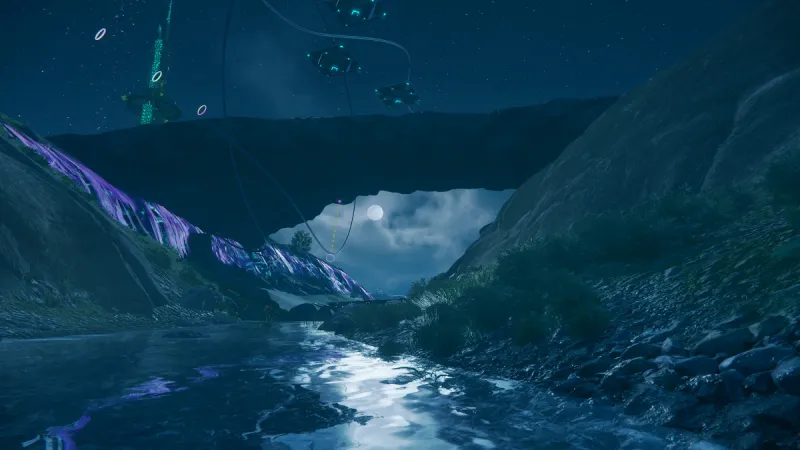
This feeling results from a ton of experimentation and iteration from Sonic Team to transition the franchise away from linearity. “We’ve been building high-speed action on a path for more than 20 years, so it wasn’t easy to get rid of it,” Iizuka says. “For example, it’s like taking F1 racing and getting rid of the course to drive on a wide, flat plain. That wouldn’t be any fun, would it? So, in the early stages of the project, we kept creating the island terrain where the game would be set over and over in search of the ideal open zone.”
Exploration elements reminiscent of the most successful open-world titles remain intact as I find a basic switch-based puzzle. By activating each switch, I solve the puzzle and remove the clouds covering that portion of the map. I take the opportunity to see what else this game has to offer. I zoom out on the map, revealing the massive scope of Kronos Island. With Sonic able to move across the world at such breakneck speeds, the map needs to be significant to deliver enough content for the hedgehog to explore. Thankfully, this initial glance at the map and subsequent exploration quell any concerns I had that Sonic would be able to speed across too quickly.
Another concern I had was that the world would be too empty. Early glimpses at the game heightened those concerns, but as I play more, the spacing of the enemies makes sense with how quickly Sonic moves through the environment. Enemy encounters feel balanced in their pacing, and the puzzles, collectibles, and discoveries feel appropriately divvied out over my hourslong playtime.
One of Sonic Team’s focuses was the criticism that recent games have been too short. With Frontiers, players won’t have to worry about that. “Whenever we work on the concept for a new game, we always refer to the reaction to the previous games and user feedback, so there are a lot of lessons, but one of them would be playthrough time,” Iizuka says. “The playthrough times ended up being short for the previous games, but due to the open zone and other factors, there has been a substantial improvement this time.”
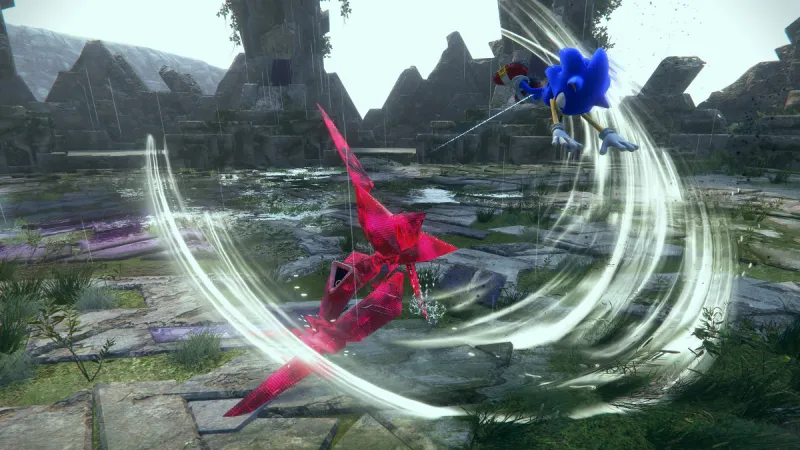
Sonic Frontiers gives players more robust combat against enemies unlike anything the series has seen
While I’m checking out the scale of the world, I decide to look at nearby points of interest. As I reveal more of the map by completing these environmental puzzles and challenges, I learn the locations of destinations such as Cyber Space portals, collectibles, and boss fights. However, this is a Sonic game built on exploration and speed. I don’t want to be in and out of my map the whole time, so I opt to use the waypoint and directional navigation systems permanently positioned at the top of the screen to minimize my time in menus.
Running through the world, I spot an icon featuring two crossed swords, indicating a boss battle. I decide that’s my destination. En route, enemies populate the world. The creatures assaulting me appear to be a combination of organic and robotic components. I quickly close the distance to individual enemies with the homing attack button. Once in tight, I push that same button for a combo consisting of kicks and punches. These enemies are basic and easily defeated, but later enemies require more tactical approaches.
“In addition to high-speed action, the other big part of Sonic Frontiers is fighting enemies,” Iizuka says. “In previous Sonic games, combat was kind of like an accent that gave the high-speed action a sense of rhythm. This time, we’re adding a greater sense of tension and tactics to the combat. All of the enemies have been designed based on tactics.”
I dispatch the creatures and receive skill pieces and seeds, which I can use to strengthen Sonic in different ways. Skill pieces contribute to a meter as you collect them, providing you with a skill point each time you fill it. To grant additional benefits, I can trade the seeds I find to mysterious creatures known as Kocos, who inhabit the island. If I find a special type of Koco, I can trade seeds to improve Sonic’s attack or defense. Unfortunately, I haven’t yet found any special Kocos, and while I don’t have enough pieces for a skill point, that first encounter gave me an excellent head start.
Continuing through the world on the way to the boss battle, I notice all the level-design conventions fans expect from a traditional Sonic game – rails, springs, lines of rings – transposed into this open-zone format. By clicking the stick, I perform the lightspeed dash move introduced in Sonic Adventure, sending the Blue Blur along the line of rings. Sonic Team uses this to significant effect in exploration, giving me plenty of ring lines to dash along to reach new areas.
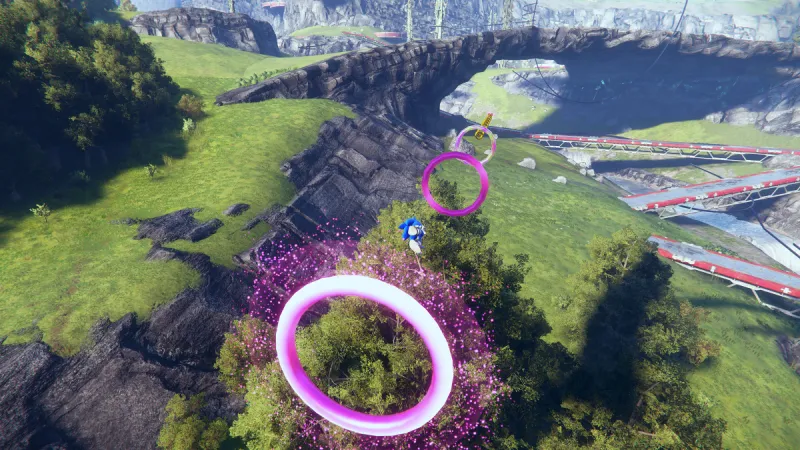
After grinding some rails, I arrive in the clearing marked by the “formidable enemy” icon. I find a Ninja, an imposing robot with blades for arms. I try rushing in as I did with the initial batch of enemies, but the Ninja isn’t having it. After using the homing attack to get close, I land a couple of quick melee attacks, but it loads up and slashes Sonic, sending him and many of the rings I collected flying. These world bosses are often bigger than the standard enemies and have unique attack patterns you need to study.
The Ninja has a decent health bar and is quicker than I expected, but Sonic is still faster. It destructively dances around the clearing, spinning its blades in a deadly display. While keeping my distance, I notice an opening after the Ninja’s spinning ceases. I home in on the boss and string together another combo, chipping away at the health bar. I repeat this process a couple more times, dodging incoming attacks and landing effective combos until the foe erupts into a glorious purple blast. Bosses leave behind Portal Gears, granting me access to additional Cyber Space levels. Defeating this particular Ninja opens a massive door, inviting me to a previously unreachable part of the map.
Blue Streak Speeds By
Blue Streak Speeds By
I storm through the newly opened gate, immediately finding a platforming sequence rewarding me with rings and a seed. A new puzzle also awaits, this time focused on rotating statues to face the correct way. After solving this still-basic task, another door opens, and I receive a message that I can now unlock Sonic’s Cyloop ability.
While Sonic has long had adventures where he obtains abilities throughout the game, Sonic Frontiers expands the concept by implementing a complete skill tree – the first of its kind in a Sonic game. “Starting out with Sonic at full power would make the combat simple and repetitive, so we made it so the player gradually unlocks Sonic’s abilities through the skill tree,” Iizuka says. “The player collects the points necessary to unlock skills by defeating enemies and exploring the island, so they can unlock more powerful skills by playing longer.”
Throughout the campaign, you can unlock abilities like Sonic Boom (shoot projectile blades mid-combo), Wild Crash (run towards enemies with a zig-zag pattern to avoid their attacks), and Speed Burst (increased power when you max out your combo meter). The tree also features hidden skills you unlock as you progress in the main story.
After checking out the skills I’ll have access to in the future, I use my available skill point to obtain Sonic’s Cyloop ability. This move, when activated, leaves a blue band of light behind him while moving. If you make a complete circle, you can trigger various effects. For example, closing a Cyloop circle in the middle of a field spawns rings, while doing it around particular objects in the environment causes unique interactions; in my next puzzle, I use the Cyloop to extinguish a set of torches simultaneously.
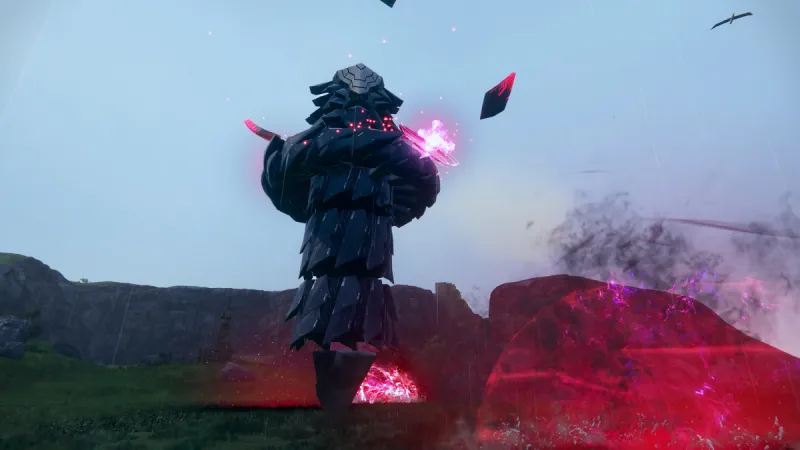
When the next batch of enemies spawn, I run a circle around them and deal area-of-effect damage with this new move; it’s not terribly powerful, but it helps with crowd control. Later on, you can unlock the ability to quickly and automatically draw a Cyloop circle, which sounds like it would come in handy in battle. But that’s not something I’ll see today.
As I open more areas in the world, I notice that stage elements like springs and rails populate. While Sonic is already moving through the world faster than any other character in an open-world game I’ve played, these elements help traverse the world quickly without removing you from the immersion through things like traditional, menu-based fast travel.
Kronos Island delivers discoveries at a rapid clip. Moments after solving that puzzle and unlocking Cyloop, I find another Cyber Space portal. It asks me if I want to access it using my Portal Gears, but I don’t have enough. Luckily, this realization is met with a seemingly serendipitous encounter as a tall, imposing boss falls from the sky. This boss, appropriately named Tower, is made up of several segments. It flings projectiles my way, but I can approach it by running in its direction and dodging to the left and right with the shoulder buttons. Once I reach it, I pull off a combo on one of the segments to destroy that piece of the boss and make it just a little shorter.
After knocking it down a notch (literally), it begins floating around. Now, I must chase it while it attacks. Eventually, I catch up to it and take out the next piece of the Tower, causing it to shrink again. The systematic nature of this boss, where Sonic must destroy it piece by piece, is supremely satisfying, and it reminds me of the Egg Rocket boss from Sonic the Hedgehog 3’s Launch Base Zone. Like with that boss, I keep attacking the Tower, and once I obliterate it, I’m rewarded with enough Portal Gears to access Cyber Space once again.
This Cyber Space stage, 1-2, is seemingly inspired by Sonic Unleashed. There are a ton of rails to grind on, plus several Eggman Robots to blast through. I’m given a Vault Key as my reward. This new type of key is used on Chaos Emerald Vaults. I open my map immediately upon coming back to the real world and mark the nearest Chaos Emerald Vault with a waypoint.
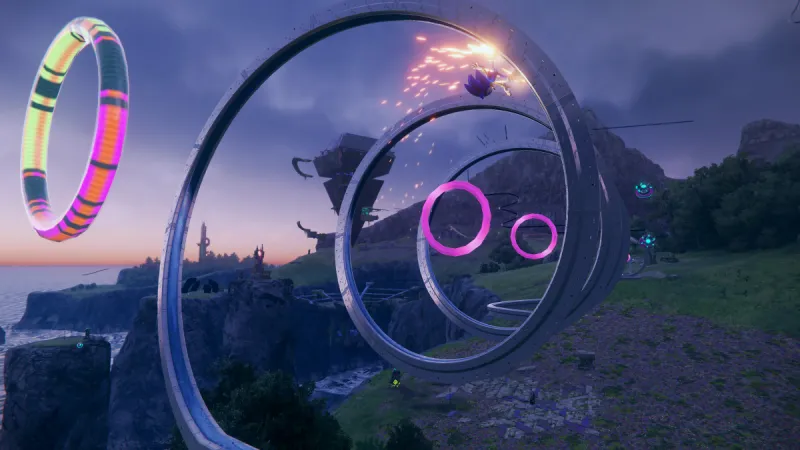
After arriving at the Vault and obtaining the emerald, the world opens a lot more. Everything to this point was essentially a tutorial; a message pops on the screen letting me know I’m free to explore the island. With the missions of discovering portals, solving puzzles to reveal the map, and obtaining more Chaos Emeralds, I speed off into Kronos Island with a new sense of freedom.
Falling Free In The Wind
Falling Free in the Wind
I decide I should track down more bosses to unlock additional Cyber Space portals. However, on my way to the one I marked on the map, I spot a familiar face: Amy! Sonic runs up to her, but she’s trapped, seemingly in Cyber Space. A cutscene shows the back of a mysterious character watching from the distance as Sonic learns he must gather collectible items related to the characters throughout the world to free his friends from Cyber Space. For Amy, that collectible is hearts.
“Sonic’s goal is to help his missing friends, so he’ll be working toward that goal throughout the game,” Iizuka says. “And as the mysteries and history of the island are gradually revealed, he will be drawn into a different, larger goal.”
The story of Sonic Frontiers is written by Ian Flynn, who’s been writing fan-favorite Sonic the Hedgehog comics across two publishers (first Archie and now IDW) since 2006. “Ian has been working as a comic writer for a long time, so I was very familiar with his work, but after reading the IDW comics, I was even more impressed with his talent,” Iizuka says. “That’s why I wanted to ask him to work on the story for the game. He knows the characters well, so he brought a great improvement to the characters’ emotions and dialogue.”
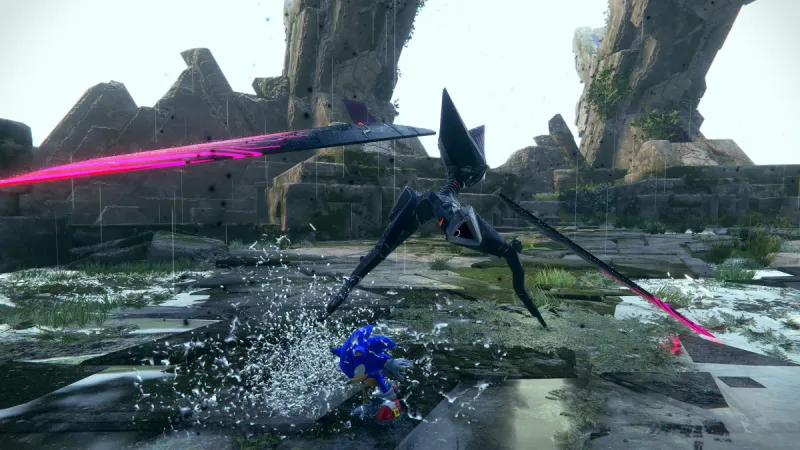
Flynn also drops in various references to other games in the series. According to Iizuka, these short voice lines, such as one where Sonic talks about how Kronos Island would be a great location for a Chao Garden, are meant to establish that not only is this a continuation of the Sonic story we know from previous titles but that it’s the latest game on the Sonic timeline.
Following the Amy cutscene, I begin seeking out hearts, which are scattered throughout Kronos Island. I pick up the nearby collectibles, but I have unfinished business in the area: a boss battle. And nothing could have prepared me for the sheer scale of what I’m about to confront: Asura, a beast the size of a building. The massive monster slams its arm into the ground, but I dodge it. While it’s grounded, I run up its limb to reach the top. While there, I land a combo on a spire on its head, causing it to crumble. Asura doesn’t much like that, so it violently shakes, sending Sonic flying off the top. I repeat this for the other two spires. Each time, the ascent becomes more difficult thanks to additional obstacles on the arm. After several botched attempts on the final spire, I’m able to take down the leviathan.
With that victory, I can enter Cyber Space 1-3. This metropolis-style stage is tougher than the previous ones, but it’s full of familiar elements like spikes, drops, springs, and rails. After making it through the level, the results screen delivers extra keys based on additional objectives like achieving an S-Rank, finishing with a set number of rings, hitting a specific completion time, or collecting all the Red Star rings in the stage. This run wasn’t my best effort, but I do manage to come away with two extra keys. This gameplay loop of tracking down bosses, entering Cyber Space, and earning progress towards keys emerges as one of the prominent parts of Sonic Frontiers’ early hours, but it’s far from all you can do.
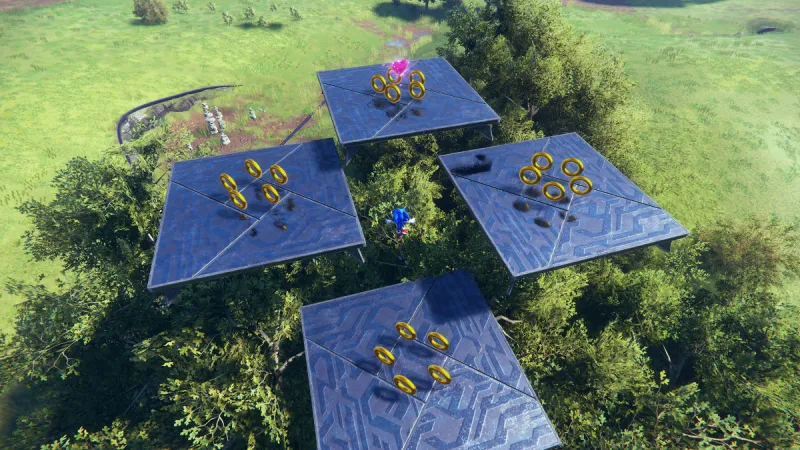
Following 1-3, a cutscene plays, showing Eggman stuck in Cyber Space. As he tries to figure out how to get out of this digital prison, the scene flashes to Sonic in his own predicament. An enormous Titan looms over our blue hero. A childlike character (possibly the one from the earlier cutscene with Amy) appears to Sonic and warns him not to attack the Titan. Sonic fails to heed the warning, and the headstrong hedgehog hurtles at it. With no effort at all, the Titan sends Sonic soaring in the opposite direction; he’s clearly no match. Sonic realizes he needs the Chaos Emeralds if he’s going to stand a chance against something so powerful.
Endless Possibility
Endless Possibility
I continue my mission from before, collecting Portal Gears by defeating bosses so I can enter Cyber Space and earn Vault Keys. During my time exploring these Cyber Space stages, I play through a Chemical Plant Zone-inspired stage and another that takes its design and thematic inspiration from Green Hill. However, that’s not all that happens. I encounter another familiar face in one portal: Big the Cat.
The friend to Froggy is ready with his fishing rod and teaches me how to take part in Sonic Frontiers’ fishing minigame. Landing my first fish adds a token to my inventory. With this new currency, I can buy various items like Portal Gear fragments, voice diaries, Vault Keys, or even the sequence items like Amy’s heart collectible. In the future, I’ll need to give Big purple coins from around the world to get additional chances to fish. I don’t waste too much time in the portal, but I make a mental note to keep an eye open for purple coins; it seems like that shop he’s running could come in handy.
Part of the aforementioned Sonic Cycle is that additional characters appear alongside Sonic in the adventure, but we shouldn’t expect to see too many of these friends in Frontiers.
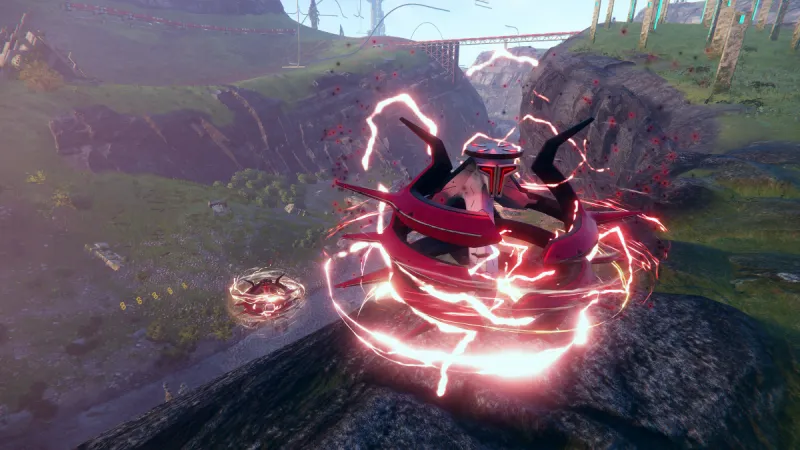
Between Cyber Space portals, I encounter a Hermit Koco. Finally, all those seeds I’ve been collecting will pay off. By trading seeds to Hermit Kocos, you can decide between bolstering your strength or defense. I choose to load up on strength, giving Sonic more powerful homing attacks and combos. Later, I find an Elder Koco, who enhances your ring limit or increases Sonic’s top speed if you return lost Kocos from across Kronos Island. With the Elder Koco, I opt to dial Sonic’s speed up. It might not be as noticeable as his boost in attack power, but every little bit helps when you’re exploring such a large island. In addition, the world might help you get around quickly with rails and springs as you expand the map, but if you want some good, old-fashioned menu-based fast travel, you can warp to the Hermit and Elder Kocos you find on the map.
Speaking of traveling, those earlier bosses aren’t the only hostile creatures I encounter while exploring the island. I confront a few different enemy types around the area where I battled the Asura. One type is spherical and covered with blob-like armor, with an electric current that activates if you get near. To take it down, you need to land successive combos when it’s not electrically charged and before it can regenerate its armor. Another is a heavily armored creature that appears completely impenetrable, but that initial assumption proves false once I try using Cyloop on it. Finally, a wheel-like enemy rolls towards Sonic, and while it doesn’t appear much of a threat on the surface, it explodes if you give it too much time or defeat it.
I also find another Ninja in the world. While the first encounter was a bit of a challenge as I was still grasping the controls, this battle is a breeze. The ease of this fight is mainly due to me having a couple more hours of gameplay under my belt and because I just learned how to execute a parry. If I time the parry just right with the Ninja’s incoming attack, Sonic counters and unleashes a monster combo that wipes out a good portion of the boss’ health bar. After that, all that’s left to do is clean up the meager remaining amount of health before continuing with my missions.
Before moving too far away, I find a stockpile of Eggman tech. I’m not sure what purpose it serves aside from informing Sonic that his archnemesis is lurking somewhere, but for now, it’s useless to me. Instead, I explore the giant rail playground suspended above. There, I rack up a stockpile of rings and add several of Amy’s hearts to my collection. Each time I hit new heart-collection milestones, I get new cutscenes and missions progressing that portion of the story.
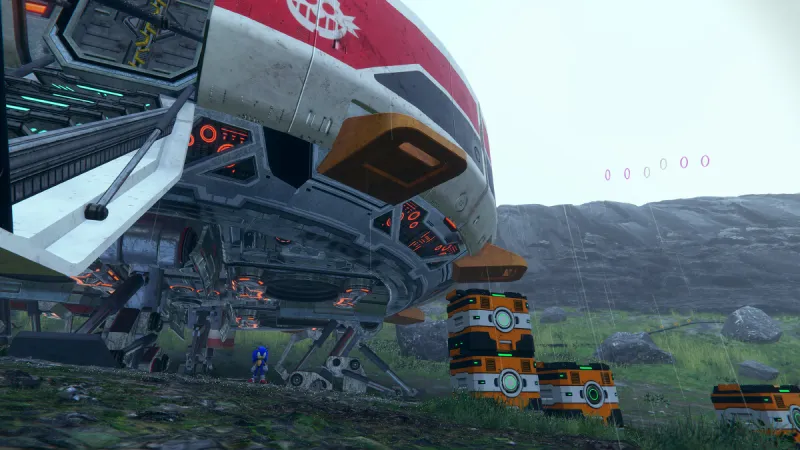
Eggman is featured in several story sequences, but how he fits into the broader narrative remains to be seen
The missions Amy gives me are simple enough (I found collecting the hearts around the world the most challenging part), but the last task during my hands-on time takes a few attempts. Amy’s mission chain centers around helping the Kocos of Kronos Island. The final one I play involves shepherding several lost Kocos back to their mother. However, there’s a twist: You must avoid getting hit by explosions and complete it before time expires. I don’t herd enough of them to the mother in time on one attempt, and on the second attempt, I get hit with three explosions, ending my run. On the third attempt, I’m able to push the Kocos to their mom and complete the mission. I receive another Chaos Emerald for my trouble and also a new cutscene. I won’t spoil anything, but it involves further unraveling the mysteries of the island and some major hints that things might not be how they seem.
As I gather more hearts, I find a different kind of puzzle. After using Cyloop to activate it, I need to blast a ball through a hoop with my homing attack. Meanwhile, another one gives me a timer and a destination on the top of a giant structure that I need to reach. I quickly achieve the former; I’ve been honing my homing skills since Sonic Adventure on Dreamcast, but the latter puzzle took me a few attempts. I found the recipe for success uses one of Sonic’s most exciting traversal skills: the wall run. Sonic can climb up particular walls, but why crawl when you can sprint? It’s easier to make a mistake, but a lot faster than climbing.
While I’m at the top of the giant structure, I glimpse the sprawling island. I spot many varied areas I won’t have enough time to explore during my hands-on session. There are so many mysteries on Kronos Island, from more towering buildings to additional portals to an area that appears to be a giant symbolic disc-shaped platform held up by a cable system. With not much time left before saying goodbye to Frontiers, I decide to pursue the most exciting thing I saw atop that structure: a new boss type.
This creature is known as a Flyer. It soars through the world like a dragon with a long tail behind it. I guide Sonic onto its tail, which serves as a runway to dash along. Since it also acts as a treadmill of sorts, Sonic must use his speed, and I must use my reflexes to dodge the blasters it sends my way. If I can avoid enough attacks and land my own, the boss touches down nearby, and the battle becomes an arena-style fight. I need to dodge lasers again, but this time in a stationary, traditional boss battle.
The Flyer gave me a run for my money, but it was one of my favorite moments from my time with Sonic Frontiers. The bosses I encountered in the world are diverse and eclectic in the ways you must approach them. If the creatures I faced are any indication, this world houses many fun things to find as you speed through the beautiful open zone.
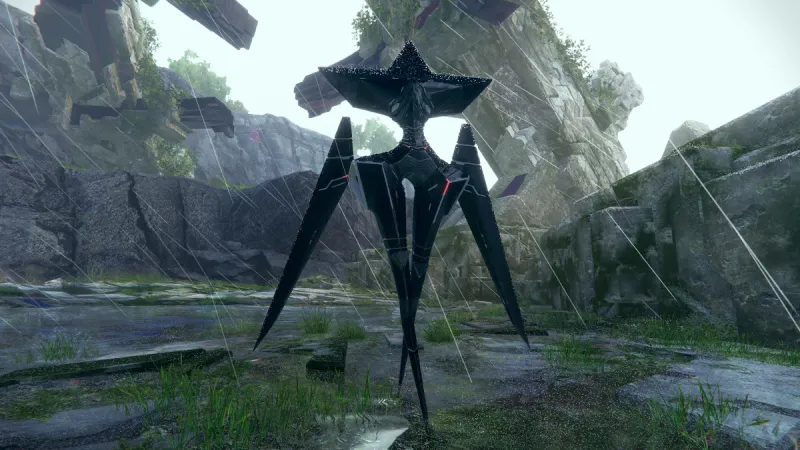
Give Us a Reason and We’re On Our Way
Give Us a Reason and We’re On Our Way
Even after hours with Frontiers, there are still many questions I can’t help but ponder. I have no idea what’s going on with Kronos Island and the mysterious creatures that inhabit it, how the story will progress, or how Eggman fits into all of this, but I’m relentlessly intrigued.
Should Sonic Frontiers prove successful, fans should expect more titles in this open-zone style. According to Iizuka, the goal of this project from the start was “to evolve the linear, stage-clearing 3D action that began with Sonic Adventure in 1998 and create a game that would be the cornerstone of future Sonic games.”
While we won’t know how this game will turn out until later this year or if the open-zone concept truly is the future of the Sonic franchise, the first title that utilizes it shows more potential than I can recall for any 3D Sonic game. If Sonic Frontiers delivers, the future is once again bright for Sega’s flagship franchise.
This article originally appeared in Issue 347 of Game Informer.

